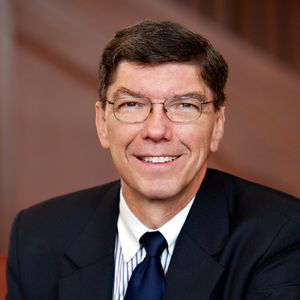Clayton M. Christensen
- Birthdate
- 1952/04/06
- Birthplace
- Salt Lake City, Utah
- Associated organizations
- Harvard Business School, The Church of Jesus Christ of Latter-day Saints, Innosight, White House Fellow, Tsinghua University in Taiwan
- Fields of study
- Economics, Econometrics, Masters of Business Administration
- Awards
- 2015 Edison Achievement Award for contributions to the world of innovation, most influential business thinker in the world in the 2011 and 2013 Thinkers50 lists, 2011 Thinkers50 Innovation Award for his application of disruptive innovation to the social issues of education and healthcare, 2010 James A. Hamilton Award from the American College of Healthcare Executives, 2010 Lifetime Achievement Award for Disruptive Innovation, Co-winner of the 2013 Silver Axiom Business Book Award, 2009 Big Picture Award, Second Place McKinsey Award for the best article in Harvard Business Review, five honorary doctorates and an honorary chaired professorship at the Tsinghua University in Taiwan
Biography
Clayton M. Christensen is an American scholar, writer, educator, a Church of Jesus Christ of Latter-day Saints (LDS) church leader, and business consultant. He is currently a Kim B. Clark Professor of Business Administration in the Harvard Business School, where he teaches the elective Building and Sustaining a Successful Enterprise [1]. Within the history of engineering and technology, he is predominantly known for his 1997 Global Business Book Award winning work The Innovators Dilemma, where he first coined the term "disruptive technology".
Clayton M. Christensen was born on April 6th, 1952 in Salt Lake City, Utah. He attended Brigham Young University (BYU) for his undergraduate degree, where he eventually interrupted his studies to volunteer in Korea with the LDS Church from 1971-1973. During this time frame Korea was known to be one of the poorest nations within Asia, and as a result of his volunteering experience, he developed a deep understanding of personal happiness, its separation from wealth, and valued the prospect of knowledge to a higher degree. [2]
Coming back from Korea and into his senior year at BYU, Christensen graduated as the summa cum laude, and was accepted into Oxford as a Rhodes Scholar, where he received a M.Phil. in applied econometrics in 1977. Following his studies at Oxford, Christensen went on to receive a MBA with High Distinction from the Harvard Business School in 1979, graduating as a George F. Baker Scholar. In 1982 he went on to be named a White House Fellow, and served through 1983 as an assistant to U.S. Transportation Secretaries. He attended Harvard again in 1992, where he was rewarded a DBA from the Harvard Business School later that year. He eventually went on to become a faculty member, and received full professorship with tenure in 1998 [3] .
During his time pursuing a DBA at Harvard, Christensen began his research into disruptive innovation; he asked himself why large, prominent and urbanely successful companies with brilliant CEO's and managers often failed. It was this research that lead to the publication of his best selling book The Innovators Dilemma, which goes into the ideology that new innovative technologies often spell the deaths of professions and large prominent markets. [4]
As a result of this publication, the term disruptive technology is coined. Several examples such as the printing press disrupting scribes hand writing books, computers replacing typewriters and its industry, to the the invention of the nuclear bomb illustrate this point.
References
- ↑ http://www.innosight.com/about-us/clayton-christensen.cfm
- ↑ http://www.deseretnews.com/article/700086287/Clayton-Christensen-Just-a-guy-from-Rose-Park.html?pg=all
- ↑ http://www.claytonchristensen.com/biography/
- ↑ http://www.deseretnews.com/article/700086287/Clayton-Christensen-Just-a-guy-from-Rose-Park.html?pg=all
